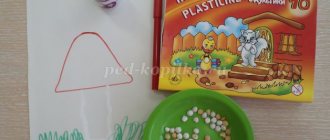Article card index of work assignments in the senior group. Author: Bogdanova Olesya Dmitrievna
Task No. 1. “Maintaining order in the closet with toys and manuals.” Goal: to teach children to independently arrange toys and aids, maintain order in closets, and wipe dust.Task No. 2. “We wipe the window sills with a damp rag in the group room and bedroom.” Goal: to teach children to follow the following rules when working with water: roll up their sleeves, wet a cloth and wring it dry, and rinse it in water when it gets dirty.
Task No. 3. “We help the assistant teacher make clean bed linen.” Goal: To teach how to consistently make bed linen, to teach children to provide all possible assistance to adults.
Task No. 4. “Canteen duty.” Goal: independently and conscientiously perform the duties of a duty officer; wash your hands thoroughly, put on the clothes of the person on duty, set the table correctly, put away the dishes after eating, sweep the tables with a brush and sweep the floor.
Task No. 5. “Duty in the training area” Goal: independently and conscientiously perform the duties of the duty officer: lay out materials and manuals prepared by the teacher for the lesson on the tables; wash, if necessary, put them back in place after class.
Task No. 6. “Cleaning up building material.” Goal: To teach how to wash, dry and lay building materials, to teach children to constantly and promptly maintain order in the play corner, to wash building materials with a soapy solution prepared by the teacher, to rinse it, and to dry it; observe the rules of personal hygiene.
Task No. 7. “Cleaning the play corner.” Goal: to teach children to put on work aprons before starting work; keep toys in order, wash them, dry them, wipe them and put them in place.
Task No. 8. “Washing napkins used in visual arts classes.” Goal: to teach children the skills of soaping, rinsing and wringing out napkins, to continue to form a work culture (tidyness in the process of work).
Task No. 9. “Wipe the cabinets in the dressing room (together with the assistant teacher).” Goal: to teach children to maintain order in their personal wardrobes: empty the closet of clothes and shoes, wipe the shelves with a damp cloth, and put things neatly in place.
Task No. 10. “Repairing books.” Goal: teach children to glue books, use glue and scissors correctly.
Task No. 11. “Let’s arrange the chairs in a certain order.” Goal: Continue to develop work skills; carry out the assignment carefully, quickly, diligently.
Task No. 12. “We wash doll bedding and clothes.” Goal: To consolidate the ability to wash doll clothes, to accustom children to neatness and cleanliness.
Task No. 13. “Cleaning in a corner of nature.” Goal: To consolidate the skills and abilities of caring for the inhabitants of a living area and caring for plants. Cultivate a desire to work, a sense of responsibility for the assigned work.
Task No. 14. “Repairing boxes for waste material.” Goal: To consolidate technical skills in working with scissors and glue, to cultivate frugality, and the ability to work collectively.
Task No. 15. “Wipe the window sills and furniture.” Goal: Work carefully with water, improve work skills in the process.
Task No. 16. “Helping the nanny in laying out bedding on the beds.” Goal: To teach how to sort bed linen according to their belongings, to cultivate a desire to help the nanny and respect for other people’s work.
Task No. 17. “Cleaning the dining room.” Goal: To learn how to properly set the table, put away dishes after meals, sweep tables with a brush and sweep the floor.
Task No. 18. “We have order in our closet.” Purpose: To teach children to be careful when folding things in a coat closet.
Task No. 19. “Let’s prepare equipment for the lesson.” Goal: To develop a sense of responsibility for the assigned task, to learn how to carefully lay out materials and equipment for classes.
Task No. 20. “Changing towels.” Goal: To develop a desire to work, to be able to offer one’s help to someone.
The use of work orders in organizing the work of a preschooler
Definition 1
A work assignment is a form of organizing the work activity of a preschool child, presented in the form of a specific task that the child needs to complete on his own or in interaction with other children.
Labor orders come in the form of demands obliging the child to perform some task of a labor nature. Assignments help in solving various educational problems. They are focused on the development of the child’s work activity, as well as the education of the moral, aesthetic, physical and intellectual properties of the growing personality.
Labor activity is important in raising a preschool child. It promotes the harmonious and comprehensive development of the individual, which is what the education system is currently focused on. In addition, work activity helps in revealing the creative potential of the individual and develops his mental abilities.
Are you an expert in this subject area? We invite you to become the author of the Directory Working Conditions
Note 1
Labor education develops a child’s respect for work and activates his desire to engage in labor activity and work for the good of society. From childhood, a child must understand the importance of work for himself, his loved ones and society as a whole.
The labor activity of a preschool child is realized in three main forms:
- Work assignments.
- Duty roster.
- Labor activity in a children's team.
Work assignments are the simplest form of organizing the work activity of a preschooler. They begin to be given to children from one and a half to two years of age. At this time, orders are individual and designed to be completed quickly. Long-term assignments that require a large amount of mental and physical effort are inappropriate during this period of development. Further, as the child develops, work assignments become more complex and take on a longer duration.
Finished works on a similar topic
Coursework Assignment as a form of organizing everyday work in the middle preschool age 410 ₽ Abstract Assignment as a form of organizing everyday work in the middle preschool age 230 ₽ Examination Assignment as a form of organizing everyday work in the middle preschool age 210 ₽
Receive completed work or specialist advice on your educational project Find out the cost
When a child is in a preschool educational institution, he is faced with a wide variety of work assignments. This allows the child to develop an interest in work activities, captivates him and allows him to develop in the work direction of activity.
Labor assignments perform educational and developmental functions. They are successfully implemented with the optimal guidance of the teacher in the work activities of preschoolers.
The organization of work assignments can be individual or collective. Collective work assignments foster a sense of collectivism, help children build social relationships and interaction, and foster hard work and responsibility. Collective assignments are good because they help the child realize the importance of completing his assignment and bearing responsibility for it. After all, if the child does not complete his part of the task, then the assignment will not be completed and the entire team will suffer.
Work assignments should be given to children regularly, only in this case they will have an effect in labor education.
CARD FILE OF LABOR ACTIVITY ON A WALK.
Transcript
1 CARD FILE OF WORK ACTIVITY ON A WALK. First junior group. Prepared by teacher of the 1st junior group Inchina A.N.
September 2 Labor assignment “Let’s collect the toys at the end of the walk” teach how to carry out simple tasks. The work assignment “Let’s collect sand in the sandbox” teaches how to carry out simple tasks. Work. Let's collect twigs on the site and involve them in carrying out simple tasks. Work. We are building a road of sand, teaching us to work side by side with each other. Work. “Let’s sweep away the sand from the sides of the sandbox” to cultivate a desire to work together with the teacher. Work. We collect leaves to help the janitor. Work. Let's collect sand in a sandbox and use it to carry out work assignments. Work. We collect toys after a walk to cultivate the desire to put away toys after playing. Work. Let's collect leaflets to cultivate the desire to carry out assignments. 0 Labor Help in harvesting potatoes to cultivate a desire to help. 1 Labor. Collect sticks on the site and involve children in completing assignments. 2 Labor. “Collecting twigs” to teach people to work. 3 Labor. “Take the toys to the group” teach them to put their toys away independently after a walk. Work. Pour sand into the sandbox to teach how to run errands. 5 Labor. We sweep the sides of the sandbox to cultivate the desire to work together with adults.
3 October Labor. “Let’s help the janitor clean the area” to instill in children a desire to help adults. Work. Game exercise “Collect leaves” to teach how to carry out work assignments. Work. Cleaning the kindergarten area to cultivate a desire to help adults. Work. Collect toys at the end of the walk to accustom them to work. Work. We collect leaves in a pile to cultivate a desire to help adults. Work. “Let’s collect sand in the sandbox” involve children in completing assignments. Work. Collect branches on the site and involve in carrying out work assignments together with children of the older group. Work. Offer to help the janitor collect leaves from the area. Cultivate a desire to help adults. Work. Collect leaves in a certain place and involve in carrying out simple tasks. 0 Labor “Collect pebbles on the site” involve children in completing simple tasks. 1 Labor. Helping the janitor clean the area encourages a desire to help adults. 2 Labor. “Collecting leaves in a bucket” teaches how to carry out simple tasks. 3 Labor. Helping the janitor clean the area maintains the desire to help. Work. Sweep the gazebo to get used to work. 5 Labor. “Let’s gather the twigs in a heap” to cultivate the desire to work.
4 November Labor. Let's collect pebbles on the site and teach them how to carry out simple tasks. Work. We collect leaves in a bucket to cultivate the desire to work together with adults. Work. Sweep the gazebo and teach how to carry out simple tasks. Work. Providing all possible assistance in clearing the area of leaves will instill a desire to help. Work. We collect the twigs in one place to teach them to carry out simple tasks. Work. Sweep in the gazebo and involve in carrying out work assignments. Work. Collect toys at the end of the walk to cultivate the desire to carry out work assignments. Work. Collecting twigs, game “How many twigs did you bring?” cultivate interest in work, teach to distinguish between the number of objects. Work. We collect pebbles in a bucket and teach how to carry out simple tasks. 0 Labor “Let’s sweep in the gazebo” involve in carrying out simple tasks. 1 Labor. We will sweep around the gazebo and involve you in carrying out assignments. 2 Labor. Let's sweep the path from the snow and cultivate the desire to work together. 3 Work assignment “Sweep the sides of the sandbox” to teach how to carry out simple tasks. Work. We collect branches in a pile to cultivate the desire to carry out the simplest tasks. 5 Labor. Invite children to sweep the path and develop a desire to carry out assignments.
5 December Labor. We sweep the path from the snow to cultivate the desire to work together. Work. “We shovel the snow” - completing assignments. Work. We collect toys at the end of the walk and teach everyone to work together. Work. Hanging feeders will instill a desire to work together with the teacher. Work. “Sweeping in the gazebo” involves children in carrying out simple tasks. Work. Feeding birds instills a desire to care for birds. Work. We collect branches in a pile to cultivate the desire to work for everyone together. Work. Sprinkling the paths with sand Explain to the children that when it is very slippery, the paths are sprinkled with sand. Cultivate a desire to help adults. Work. Collecting toys is taught without an adult’s reminder to collect toys after a walk. 0 Labor Sweep the path and teach how to work together with older preschoolers. 1 Labor. “Let’s sweep in the gazebo” involve in carrying out simple tasks. 2 Labor. Raking snow into a pile in preparation for making buildings from snow, involving children in labor. 3 Labor. Helping the janitor clear the snow from the paths encourages children’s desire to help adults. Work. Collect snow in a pile to build a slide and involve in carrying out assignments. 5 Labor. Let's decorate the buildings with colored ice to foster a desire to decorate the territory of the kindergarten.
6 January Labor. “We are building a slide for Katya’s doll” to teach how to carry out work assignments. Work. Learn to work together when shoveling snow with shovels. Work. Helping a janitor clear snow will foster a desire to help. Work. We are building a slide to cultivate the desire to participate in joint work. Work. Clearing paths of snow and running errands. Work. We decorate the snow sandbox with multi-colored pieces of ice to foster a desire to decorate the territory of the kindergarten. Work. Clearing the path to the gazebo from snow, teach how to carry out simple tasks. Work. Helping a janitor clear the area of snow will instill a desire to help. Work. Pour food into bird feeders to foster a caring attitude towards birds. 0 Labor Clearing paths of snow instills a desire to work. 1 Labor. Feeding birds on the site will foster a caring and caring attitude towards wintering birds. 2 Labor. Raking snow in one place accustoms children to work. 3 Labor. Sweep the snow in the gazebo and complete errands. Work. Feeding birds instills a desire to help birds in winter. 5 Labor. Construction of the highway to cultivate the ability to work together.
7 February Labor. “Let’s sweep the path” teaches how to carry out simple tasks. Work. Let's clear the snow from the path and get used to working together with older children. Work. “Building a house out of snow” develops children’s desire to build out of snow. Work. Feeding birds to foster a caring attitude towards birds. Work. Building a house out of snow fosters a desire to build buildings out of snow. Observing the games of older children continues to introduce relationships between people. Work. Let's sweep the gazebo and cultivate the desire to work. Work. Let's clear the paths of snow and cultivate the desire to work together. Work. Let's sweep the path and involve you in carrying out assignments. Work. Feeding birds involves children in feeding birds, fostering a caring attitude towards birds. 0 Labor Collect dry twigs and use them to carry out work assignments. 1 Labor. We carry snow in buckets to the flowerbed to instill in children the desire to participate in joint work, to explain that in the spring the snow on the flowerbed will melt, moisten the ground, and this is useful for the growth of flowers. 2 Labor. Helping clear snow from paths encourages children's desire to help adults. 3 Labor. We will clear the tables of snow and complete errands. Work. Clear the snow around the gazebo to foster a desire to work together. 5 Labor. Clear buildings of snow to cultivate a desire to work.
8 March Labor. Involve in carrying out assignments when clearing buildings of snow. Work. We collect pieces of ice in a bucket and teach how to carry out simple tasks. Work. We will clear the benches of snow and complete errands. Work. “Let’s sweep the path” involve in carrying out assignments. Work. Building a highway out of snow teaches how to work together and help each other. Work. Feeding birds teaches how to care for birds. Work. Learn to work together when shoveling snow with a shovel. Individual work. Run in different directions. Work. Clearing snow around buildings involves joint work. Work. Helping the janitor clear the area of snow will instill a desire to work hard. 0 Labor Sweeping snow from paths and running errands. 1 Labor. “Let’s collect the snow in a pile and build a slide for Katya’s doll” to interest children in completing work assignments. 2 Labor. We carry snow in buckets to a certain place to cultivate the desire to work together. 3 Labor. Learn how to build a highway together. Individual work. Onomatopoeia exercise “How does a car honk?” Work. Feeding birds continues to foster a desire to care for birds. 5 Labor. Clearing the path of snow will make you want to work together with the teacher.
9 April Labor. We collect twigs to cultivate the desire to carry out assignments. We let the branches float through the water and see if they sink or float. Work. Let's sweep the gazebo and carry out simple tasks. Work. Let's remove branches from the area to support the desire to help adults. Work. Let's sweep the gazebo and involve them in carrying out work assignments. Work. We help the janitor develop a desire to help adults. Work. Sweep the gazebo and cultivate a desire to keep the gazebo clean. Work. Let's collect the sticks to complete the errands. Work. Feeding birds maintains the desire to care for birds. Work. Sweep the central path and involve in carrying out assignments. 0 Labor Collecting twigs involves children in joint work. 1 Labor. We collect pebbles on the site and involve them in carrying out assignments. 2 Labor. Feeding the birds encourages children's desire to care for birds. 3 Labor. Let's sweep the central path to instill a desire to maintain order in the kindergarten territory. Work. We collect twigs and invite them to participate in joint work. 5 Labor. We are building a house for a doll to involve in joint construction.
10 May Labor. Sweep the gazebo to support the desire to work. Work. Let's sweep the sides of the sandbox and complete the assignments. Work. Loosening the soil in a flowerbed involves labor. Work. Let's sweep the gazebo and cultivate the desire to work. Work. Collecting toys after a walk involves joint work. Work. Collecting pebbles on the site instills a desire to carry out assignments. Work. We are building a garage out of sand and teaching how to work together. Work. Let's sweep up the gazebo to complete errands. Work. The construction of a road made of sand involves labor. 0 Labor Loosening the soil in the garden, preparing the garden for planting potatoes. 1 Labor. Help in planting potatoes to cultivate a desire to help adults. 2 Labor. Watering the flowers in the flowerbed involves doing errands. 3 Labor. We collect pebbles in the area to complete errands. Using pebbles, place various shapes in the sandbox. Work. Helping the janitor clean the area instills a desire to help. 5 Labor. Helping adults fill the sandbox with sand will foster a desire to help. 6 Labor. Helping with watering the garden will foster a desire to help.
- how much is the latest news about coronavirus in Russia today, the situation at the moment




